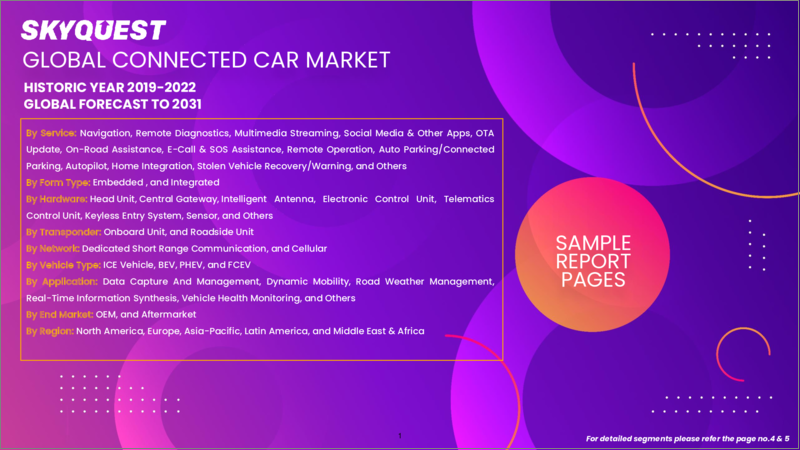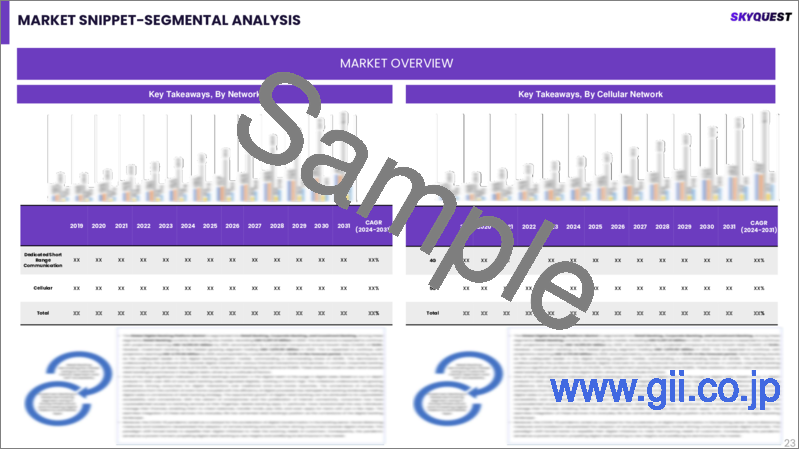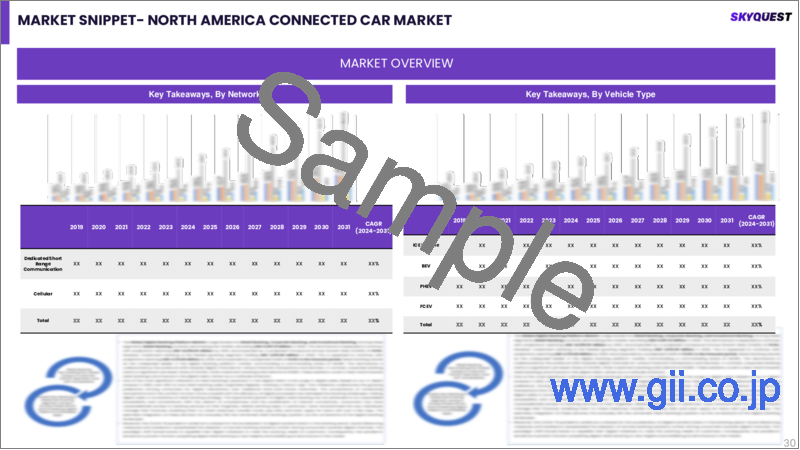|
|
市場調査レポート
商品コード
1539560
コネクテッドカーの市場規模、シェア、成長分析:サービス別、車両コネクティビティ別、最終用途別、形態タイプ別、地域別 - 産業予測、2024-2031年Connected Car Market Size, Share, Growth Analysis, By Service, By Vehicle Connectivity, By End Use, By Form Type, By Region - Industry Forecast 2024-2031 |
||||||
|
|||||||
| コネクテッドカーの市場規模、シェア、成長分析:サービス別、車両コネクティビティ別、最終用途別、形態タイプ別、地域別 - 産業予測、2024-2031年 |
|
出版日: 2024年08月15日
発行: SkyQuest
ページ情報: 英文 223 Pages
納期: 3~5営業日
|
- 全表示
- 概要
- 目次
コネクテッドカーの世界市場規模は2022年に345億6,000万米ドルとなり、2023年の412億9,000万米ドルから2031年には1,437億2,000万米ドルに達し、予測期間(2024-2031年)のCAGRで19.50%の成長が予測されています。
世界のコネクテッドカー市場は、技術の進歩、消費者行動の変化、新たな規制の枠組みなど、いくつかの重要な要因によって大きな成長を遂げています。また、様々な地域における可処分所得の増加も市場拡大を後押しすると予想されます。通信技術の進歩により車両接続性が強化される一方、IT機器は単純な制御ユニットから、エンターテインメント、ナビゲーション、テレマティクス、診断サポートなどのサービスを提供する包括的なプラットフォームへと進化しています。政府のイニシアチブは市場成長の推進に重要な役割を果たしています。例えば、米国運輸省と米国運輸省道路交通安全局は、自動車メーカーに自動車への通信機器の搭載を義務付ける規制を提案しています。SkyQuestの分析によると、米国運輸省はまた、州や地方の交通機関、自動車メーカー、機器メーカー、一般市民と協力して、自動車、バス、列車、その他の機器が相互に通信できるようにするコネクテッドカー技術のテストを行っています。コネクテッドカーは、快適性、安全性、セキュリティ、コネクティビティの強化といった機能を提供します。リアルタイム通信プラットフォームは、ドライバーの注意力維持を支援し、需要をさらに喚起します。政府のイニシアティブに支えられた5G技術と衛星コネクティビティの継続的開拓も、市場成長の原動力となっています。技術に精通した消費者とユーザーフレンドリーな技術の人気の高まりが、この拡大に寄与しています。さらに、OEMは、センサー、プロセッサー、車両管理ソリューション、無線システム、アフターマーケットサービスを提供することで、重要な役割を果たしています。しかし、車載アプリケーションへの不正アクセスが懸念されるなど、安全性やセキュリティに影響を与えかねないという課題に直面しています。SkyQuestの分析によると、バイデン政権と商務省は、中国など懸念される国の部品を使用したコネクテッドカーに関連する潜在的な国家安全保障リスクの調査を開始しました。さらに、さまざまな地域でインターネット接続が安定していないことも、市場の成長を妨げる可能性があります。こうした課題にもかかわらず、コネクテッドカーは天候、交通渋滞、駐車場などの問題に対する解決策を提供し、運転体験を向上させ、市場成長に貢献しています。
目次
イントロダクション
- 調査の目的
- 定義
- 市場範囲
調査手法
- 情報調達
- 二次データソースと一次データソース
- 市場規模予測
- 市場の想定と制限
エグゼクティブサマリー
- 市場概要見通し
- 供給需要動向分析
- セグメント別機会分析
市場力学と見通し
- 市場力学
- 促進要因
- 機会
- 抑制要因
- 課題
- ポーターの分析
主な市場の考察
- 市場の成功要因
- 競合の程度
- 主な投資機会
- 市場魅力度指数
- エコシステムマッピング
- 特許分析
- 価格分析
- 貿易分析
- 消費者と購買基準
- 規制分析
- 技術分析
- ケーススタディ分析
コネクテッドカー市場:サービス別
- 市場概要
- ナビゲーション
- オペレーションデータ
- リモート診断
- マルチメディアストリーミング
- ソーシャルメディア・その他のアプリ
- OTAアップデート
- オンロードアシスタンス
- Eコール・SOSアシスタンス
- リモートオペレーション
- オートパーキング/コネクテッドパーキング
- オートパイロット
- ホームインテグレーション
- 盗難車両の回収
コネクテッドカー市場:形態タイプ別
- 市場概要
- 組込み
- 統合
コネクテッドカー市場:エンドマーケット別
- 市場概要
- OEM
- アフターマーケット
コネクテッドカー市場:ハードウェア別
- 市場概要
- ヘッドユニット
- セントラルゲートウェイ
- インテリジェントアンテナ
- ECU
- テレマティックコントロールユニット
- キーレスエントリーシステム
- センサー
コネクテッドカー市場:トランスポンダー別
- 市場概要
- 車載ユニット
- 路傍ユニット
コネクテッドカー市場:ネットワーク別
- 市場概要
- DSRC
- セルラー
- 4G
- 5G
コネクテッドカー市場:車両タイプ別
- 市場概要
- BEV
- PHEV
- FCEV
コネクテッドカー市場:アプリケーション別
- 市場概要
- データキャプチャ・管理
- ダイナミックモビリティ
- 道路気象管理
- リアルタイム情報統合
- 車両ヘルスモニタリング
コネクテッドカー市場規模:地域別
- 市場概要
- 北米
- 米国
- カナダ
- 欧州
- ドイツ
- 英国
- フランス
- イタリア
- スペイン
- その他欧州地域
- アジア太平洋地域
- 中国
- インド
- 日本
- 韓国
- その他アジア太平洋地域
- ラテンアメリカ
- ブラジル
- その他ラテンアメリカ地域
- 中東・アフリカ(MEA)
- GCC諸国
- 南アフリカ
- その他中東・アフリカ地域
競合情勢
- 上位5社の比較
- 主要企業の市場ポジショニング(2023年)
- 主な市場企業が採用した戦略
- 市場における最近の活動
- 主要企業の市場シェア(2023年)
主要企業プロファイル
- General Motors(US)
- AUDI AG(Germany)
- Ford(US)
- Mercedes-Benz(Germany)
- Toyota(Japan)
- Volkswagen(Germany)
- Nissan(Japan)
- Volvo(Sweden)
- Honda(Japan)
- Porsche(Germany)
- Hyundai(South Korea)
- Kia(South Korea)
- Tata Motors(India)
- AT&T Intellectual Property(US)
- Aptiv(Ireland)
- Google LLC(US)
- NXP Semiconductors(Netherlands)Qualcomm Incorporated(US)
- TomTom(Netherlands)
- Zebra Technologies(US)
Global Connected Car Market size was valued at USD 34.56 Billion in 2022 and is poised to grow from USD 41.29 Billion in 2023 to USD 143.72 Billion by 2031, growing at a CAGR of 19.50% during the forecast period (2024-2031).
The global connected car market is experiencing significant growth due to several key factors, including technological advancements, shifts in consumer behavior, and new regulatory frameworks. Increased disposable incomes across various regions are also expected to boost market expansion. Advances in telecommunication technology are enhancing vehicle connectivity, while IT equipment is evolving from simple control units to comprehensive platforms offering services like entertainment, navigation, telematics, and diagnostic support. Government initiatives play a crucial role in driving market growth. For example, the U.S. Department of Transportation and the National Highway Traffic Safety Administration have proposed regulations requiring auto manufacturers to install communication devices in vehicles. According to SkyQuest analysis, the U.S. Department of Transportation is also collaborating with state and local transportation agencies, vehicle and device manufacturers, and the public to test connected vehicle technologies that enable vehicles, buses, trains, and other devices to communicate with each other. Connected cars offer features such as enhanced comfort, safety, security, and connectivity. Real-time communication platforms assist drivers in staying attentive, further fueling demand. The ongoing development of 5G technologies and satellite connectivity, supported by government initiatives, also drives market growth. Tech-savvy consumers and the increasing popularity of user-friendly technology contribute to this expansion. Additionally, Original Equipment Manufacturers (OEMs) are playing a significant role by providing sensors, processors, fleet management solutions, wireless systems, and aftermarket services. However, the market faces challenges, such as concerns about unauthorized access to automotive applications, which can impact safety and security. SkyQuest analysis notes that the Biden administration and the Department of Commerce have launched an investigation into potential national security risks associated with connected cars featuring components from countries of concern, such as China. Moreover, inconsistent internet connectivity in various regions can hinder market growth. Despite these challenges, connected cars offer solutions to issues like weather conditions, traffic congestion, and parking, enhancing the driving experience and contributing to market growth.
Top-down and bottom-up approaches were used to estimate and validate the size of the Global Connected Car market and to estimate the size of various other dependent submarkets. The research methodology used to estimate the market size includes the following details: The key players in the market were identified through secondary research, and their market shares in the respective regions were determined through primary and secondary research. This entire procedure includes the study of the annual and financial reports of the top market players and extensive interviews for key insights from industry leaders such as CEOs, VPs, directors, and marketing executives. All percentage shares split, and breakdowns were determined using secondary sources and verified through Primary sources. All possible parameters that affect the markets covered in this research study have been accounted for, viewed in extensive detail, verified through primary research, and analyzed to get the final quantitative and qualitative data.
Global Connected Car Market Segmental Analysis
Global connected car market is segmented based on service, hardware, form type, end market, transponder, network, electric vehicle type, and region. In terms of service, the market can be segmented into navigation, remote diagnostics, multimedia streaming, social media and other apps, OTA updates, on road assistance, e-call and SOS assistance, cybersecurity, remote operation, collision warning, auto parking/ connected parking, autopilot, home integration, Stolen Vehicle Recovery/Warning. Based on hardware, the market is segmented into head unit, central gateway, intelligent antenna, electronic control unit, telematic control unit, keyless entry systems, and sensors. Based on form type, the market is segmented into embedded, and integrated. Based on end market, the market is segmented into original equipment manufacturer (OEM), and aftermarket. Based on transponder, the market is segmented into on board unit, and roadside unit. Based on network, the market is segmented into DSRC, and cellular (4G, and 5G). Based on electric vehicle type, the market is segmented into BEV, PHEV, and FCEV. Based on application, the market is segmented into Data Capture and Management, Dynamic Mobility, Road Weather Management, Real-time Information Synthesis, Vehicle Health Monitoring. Based on region, the market is segmented into North America, Europe, Asia Pacific, Middle East and Africa, and Latin America.
Drivers of the Global Connected Car Market
Technological advancements, particularly in artificial intelligence, IoT, and 5G connectivity, are driving significant growth in the connected car market. In 2023, the expansion of 5G networks and the rollout of Level 3+ Advanced Driver Assistance Systems (ADAS) are expected to boost the adoption of 5G in connected vehicles throughout the decade. The anticipated introduction of 5G RedCap in 2026 will further support the integration of 5G into lower-tier vehicles, accelerating widespread adoption. By 2030, it is projected that nearly 90% of cars sold will be equipped with 5G connectivity. These cutting-edge technologies will enhance existing features such as real-time navigation and advanced telematics, leading to safer driving experiences. Innovations in connected cars will not only improve user experience by offering new functionalities but also contribute to more reliable and efficient vehicle performance.
Restraints in the Global Connected Car Market
Rising concerns over data confidentiality and cybersecurity present significant challenges to the growth of the connected car industry. As vehicles exchange vast amounts of sensitive data, including location and user habits, the risk of data breaches and theft increases. Addressing these issues is crucial for building trust between customers and ensuring the long-term success of the connected car market. Developing and implementing robust data protection measures will be essential in overcoming these obstacles and maintaining consumer confidence.
Market Trends of the Global Connected Car Market
The connected car services market is increasingly embracing subscription-based models, offering rental options that can be paid on a monthly or annual basis, in contrast to traditional ownership models. These subscription plans, such as premium offerings like the "Gold Plan," provide continuous updates and improvements to ensure that connected car systems remain current with the latest advancements and security solutions. The availability of instant services through these plans drives market growth and supports the ongoing evolution of the industry.
Table of Contents
Introduction
- Objectives of the Study
- Definitions
- Market Scope
Research Methodology
- Information Procurement
- Secondary & Primary Data Sources
- Market Size Estimation
- Market Assumptions & Limitations
Executive Summary
- Market Overview Outlook
- Supply Demand Trend Analysis
- Segmental Opportunity Analysis
Market Dynamics & Outlook
- Market Dynamics
- Drivers
- Opportunities
- Restraints
- Challenges
- Porters Analysis
- Competitive rivalry
- Threat of Substitute Products
- Bargaining Power of Buyers
- Threat of New Entrants
- Bargaining Power of Suppliers
Key Market Insights
- Key Success Factors of The Market
- Degree Of Competition
- Top Investment Pockets
- Market Attractive Index
- Ecosystem Mapping
- Patent Analysis
- Pricing Analysis
- Trade Analysis
- Consumer And Buying Criteria
- Regulatory Analysis
- Technology Analysis
- Case study Analysis
- Use of telematics control u it for predictive maintenance
- Development of low cost and versatile car telematics platform
- Utilization of zoura platform for telematics
- Enhanced autonomous driving capabilities with open autonomy private platform
- Improved autonomous vehicle performance with drive hyperion
Global Connected Car Market by Service
- Market Overview
- Navigation
- Operational data
- Remote Diagnostics
- Multimedia Streaming
- Social-Media and Other Apps
- OTA Updates
- On Road Assistance
- E-call And SOS Assistance
- Remote Operation
- Auto Parking/ Connected Parking
- Autopilot
- Home Integration
- Stolen vehicle recovery
Global Connected Car Market by Form type
- Market Overview
- Embedded,
- Integrated
Global Connected Car Market by End market
- Market Overview
- OEM
- After market
Global Connected Car Market by Hardware
- Market Overview
- Head Unit
- Central Gateway
- Intelligent Antenna
- Electronic Control Unit
- Telematic Control Unit
- Keyless Entry Systems
- Sensors
Global Connected Car Market by Transponder
- Market Overview
- Onboard Unit
- Roadside Unit
Global Connected Car Market by Network
- Market Overview
- DSRC
- Cellular
- 4G
- 5G
Global Connected Car Market by Vehicle type
- Market Overview
- BEV
- PHEV
- FCEV
Global Connected Car Market by Application
- Market Overview
- Data Capture and management
- Dynamic mobility
- Road weather management
- Real-time information synthesis
- Vehicle health monitoring
Global Connected Car Market Size by Region
- Market Overview
- North America
- USA
- Canada
- Europe
- Germany
- UK
- France
- Italy
- Spain
- Rest of Europe
- Asia Pacific
- China
- India
- Japan
- South Korea
- Rest of Asia-Pacific
- Latin America
- Brazil
- Rest of Latin America
- Middle East & Africa (MEA)
- GCC Countries
- South Africa
- Rest of MEA
Competitive Landscape
- Top 5 Player Comparison
- Market Positioning of Key Players, 2023
- Strategies Adopted by Key Market Players
- Recent Activities in the Market
- Key Companies Market Share (%), 2023
Key Company Profiles
- General Motors (US)
- Company Overview
- Business Segment Overview
- Financial Updates
- Key Developments
- AUDI AG (Germany)
- Company Overview
- Business Segment Overview
- Financial Updates
- Key Developments
- Ford (US)
- Company Overview
- Business Segment Overview
- Financial Updates
- Key Developments
- Mercedes-Benz (Germany)
- Company Overview
- Business Segment Overview
- Financial Updates
- Key Developments
- Toyota (Japan)
- Company Overview
- Business Segment Overview
- Financial Updates
- Key Developments
- Volkswagen (Germany)
- Company Overview
- Business Segment Overview
- Financial Updates
- Key Developments
- Nissan (Japan)
- Company Overview
- Business Segment Overview
- Financial Updates
- Key Developments
- Volvo (Sweden)
- Company Overview
- Business Segment Overview
- Financial Updates
- Key Developments
- Honda (Japan)
- Company Overview
- Business Segment Overview
- Financial Updates
- Key Developments
- Porsche (Germany)
- Company Overview
- Business Segment Overview
- Financial Updates
- Key Developments
- Hyundai (South Korea)
- Company Overview
- Business Segment Overview
- Financial Updates
- Key Developments
- Kia (South Korea)
- Company Overview
- Business Segment Overview
- Financial Updates
- Key Developments
- Tata Motors (India)
- Company Overview
- Business Segment Overview
- Financial Updates
- Key Developments
- AT&T Intellectual Property (US)
- Company Overview
- Business Segment Overview
- Financial Updates
- Key Developments
- Aptiv (Ireland)
- Company Overview
- Business Segment Overview
- Financial Updates
- Key Developments
- Google LLC (US)
- Company Overview
- Business Segment Overview
- Financial Updates
- Key Developments
- NXP Semiconductors (Netherlands)Qualcomm Incorporated (US)
- Company Overview
- Business Segment Overview
- Financial Updates
- Key Developments
- TomTom (Netherlands)
- Company Overview
- Business Segment Overview
- Financial Updates
- Key Developments
- Zebra Technologies (US)
- Company Overview
- Business Segment Overview
- Financial Updates
- Key Developments





